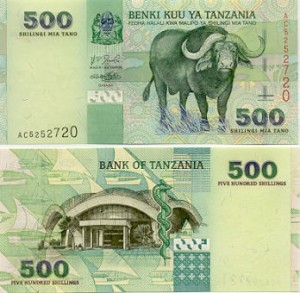By Adam Anthony
The Bank of Tanzania (BoT) plans to issue 500/- Tanzanian shilling coins, to replace the current 500 notes which wears off easily. The Central Bank Governor, Prof Benno Ndulu, said the decision follows complaints from people regarding the weakness of the green 500/- bill. This article explains the impacts of such a transition and economic repercussions. The analysis looks at what would be the impact of such a transformation not just to the public, but also to the government and the payment system within the economy. As much as this article will critically analyze the risks derived from the transition from the 500 note to a 5000 coin, the major assumption is that, the 500 note is still a better and efficient transaction instrument compared to the coin we have resolved to adopt.
In a nutshell
While speaking [on 15th July, 2014] in a morning TV interview, the Deputy Minister for Finance, Mwigulu Nchemba again, after the Central Bank’s Governor Prof. Ndulu, stressed on the ministry’s move to adopt a 500 Tshs coin that replaces a 500 Tshs note. While his argument (huge costs of replacing worn out notes) is true, he ignored the other side of the transition, that is the costs associated with the transformation. Public attention or rather worry has recently focused on the major change to replace a 500 Tanzanian shilling note with a coin of the same value. The Ministry of Finance and the Central Bank has greatly urged the public not to worry since the transition will save the government a great amount of money used often to replace worn out notes with the new ones.
The two debating sides on this transition are the government and the public. The government has based its arguments on the durability of the 500 Tshs note and thus saving costs incurred to print new notes every time the notes wear out, while the public has not really had any strong arguments. This does not necessarily mean that the government’s argument is justifiable. The transition has a broader impact on the whole transaction system in the economy together with other players such as depository institutions, retailers and government institutions to mention a few.

Though true costs and benefits are difficult to measure, previous studies such as those conducted to analyze replacing a 1$ note with a coin shows that the costs of using a 500 Tshs coin could be higher than using a 500 Tshs note.
The costs could be higher, especially to businesses that accept cash in large volumes such as banks. The effects will be summarized considering three scenarios altogether, which will emerge because of the transition, the first being the pre-coin phase, co-circulation of the 500 note and coin, and the last scenario will be the circulation of the 500 coin alone after a note withdrawn by the Central Bank.
Note that, in the economics perspective, since notes and coins will be in the same circulation, most of the economic units will prefer notes over coin and hence this period of co-circulation could also be regarded as 500-note-only circulation even though coins exist.
Since the Tanzanian central banking system has centered its argument on the fact that a 500 note wear out fast than a 500 coin, and hence the Central Bank incur costs in replacing worn out notes with the new ones, this essay will center its focus to debunk the Central Bank’s argument, and show why a 500 note is still a viable option:
1. It is not cost-effective to replace notes with coins because of two reasons; (a) higher costs of minting coins cannot be compared with the costs of printing notes, and (b) costs of replacing notes every time they wear out cannot be offset by the durability of the coins.
2. Countries like Nigeria use notes that have much higher velocity (how many times currency changes hands in the economy) such as 20 Naira with quality paper that reduces fast-wearing out of the notes. Tanzania could have considered using a different quality paper rather than resolving to coins directly.
3. The transition might offset any seigniorage value that was expected. Seigniorage is the revenue created by printing money, the difference between a monetary unit value and costs of printing it. So if the cost of printing a 500-note is 250, seigniorage is 250. The government perhaps did not consider this.
4. Most countries, including major countries like United States, do not have systems to maintain the quality and authenticity of coins compared to notes. Eventually this might result in having more counterfeit coins than how it was with the 500-note. For example, the United Kingdom experienced a substantial increase in counterfeiting of £1 coins in recent years. The Royal Mint estimates that as much as 2.8 percent of coins in circulation may be counterfeit. If Tanzania would face a counterfeit coins problem, it would have to spend a huge chunk of money to acquire machinery specifically made to detect counterfeit coins and train counterfeit specialists, a similar scenario predicted by the USSS (United States Secret Service) when analyzing the impacts of introducing a one dollar coin.
5. One of the major qualities of money is its physical attributes (portability and convenience). A 500 Tshs coin is more cumbersome than a 500 Tshs note for both, consumers and businesses as it is easier to carry several 500 Tshs notes instead of 500 Tshs coins.
Availability of substitute payment systems
Most of the countries opted to replace low-value notes with coins in the 1980s. Usually these decisions were made when other payment systems or substitutes for cash such as electronic transfers or mobile money were non-existent.
Canada replaced its lowest denomination note with a coin in 1987, Australia in 1984, and the United Kingdom in 1983. In Tanzania today, more transactions are done electronically through ways such as mobile money. With more alternatives to cash, if people are forced to use a 500-coin rather than a 500-note, Tanzanian government might experience a larger shift away from cash than ever before due to mandatory replacement of a 500-note with 500-coin.
Conclusion
The argument by the Tanzanian Central Bank that it is expensive to reprint 500 Tshs notes when they wear out is in fact true, though partly. In many countries where coins replaced low-denomination notes, the note life was between 10 to 20 months (500 Tshs note lasts for about 7 months according to Central Bank governor, Benno Ndulu), a fact that applies to Tanzanian 500 Tshs note as well. This is, as said above, a matter of paper quality. For example, the reason why a $1 note life is greater than 70 months is because the paper for $1 notes is a cotton and linen blend, as compared with the cotton substrate used in most other currencies.
Hence if durability of the note was a major reason for transition, opting to coins was an abrupt measure since other measures such as improving paper quality could have been adopted.
Source: Adam Anthony on WordPress
Adam Anthony is an Economics Graduate from Mzumbe University, Tanzania. He majored in Economic Policy and Planning with specific courses in Monetary Economics, Investment and Capital Markets. Adam is a freelance writer, with focus on development economics and sustainable development.
Email: adam.anthony[at]live.com
Twitter: @adamthony
Blog: adamthony.wordpress.com

